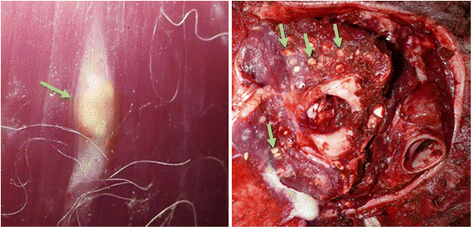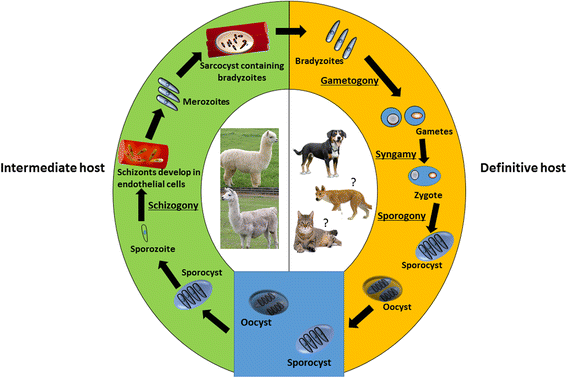Sarcocystosis in South American camelids: The state of play revisited
- PMID: 29510746
- PMCID: PMC5840700
- DOI: 10.1186/s13071-018-2748-1
Sarcocystosis in South American camelids: The state of play revisited
Abstract
Members of the genus Sarcocystis (Apicomplexa: Sarcocystidae) are intracellular protozoan parasites that infect a wide range of domestic and wild animals, resulting in economic losses in production animals worldwide. Sarcocystis spp. have indirect life-cycles where canids and felids serve as main definitive hosts while a range of domestic and wild animals serve as intermediate hosts, including South American camelids (SACs) such as alpacas, llamas and guanacos. These animals primarily occur in South American countries on Andean, elevated plains but in recent years, alpacas and llamas have become emerging animal industries in other parts of the world such as Australia, Europe and the USA due to their high-quality fiber, meat and hides. For instance, alpaca meat is becoming popular in many parts of the world due to its lower cholesterol content than other red meat, thereby it has the potential of a valuable product for both local and international markets. However, SAC meat can be degraded and/or even condemned due to the presence of macroscopic sarcocysts in skeletal muscles, leading to significant economic losses to farmers. The infection is generally asymptomatic, though highly pathogenic or even fatal Sarcocystis infections have also been reported in alpacas and llamas. Despite the economic importance of sarcocystosis in SACs, little is known about the life-cycle of parasites involved, disease transmission, epidemiology, pathogenesis, diagnosis, control and public health significance. This review article provides an in-depth analysis of the existing knowledge on the taxonomy, epidemiology, clinicopathology and diagnosis of Sarcocystis in SACs, highlights knowledge gaps and proposes future areas of research that could contribute to our better understanding of sarcocystosis in these animals.
Keywords: Alpaca; Guanaco; Llama; Sarcocystis; Sarcocystosis; Vicuna.
Conflict of interest statement
Ethics approval and consent to participate
Not applicable.
Consent for publication
Not applicable.
Competing interests
The authors declare that they have no competing interests.
Publisher’s Note
Springer Nature remains neutral with regard to jurisdictional claims in published maps and institutional affiliations.
Figures
Similar articles
-
Sarcocystis spp. of New and Old World Camelids: Ancient Origin, Present Challenges.Pathogens. 2024 Feb 23;13(3):196. doi: 10.3390/pathogens13030196. Pathogens. 2024. PMID: 38535539 Free PMC article. Review.
-
Molecular identification of Sarcocystis aucheniae in the wild South American camelid Vicugna vicugna.Vet Res Commun. 2024 Oct;48(5):3429-3435. doi: 10.1007/s11259-024-10491-0. Epub 2024 Aug 9. Vet Res Commun. 2024. PMID: 39120675
-
An update on sarcocystosis in one-humped camels (Camelus dromedarius).Parasitology. 2018 Sep;145(11):1367-1377. doi: 10.1017/S0031182018000239. Epub 2018 Jun 5. Parasitology. 2018. PMID: 29866208 Review.
-
Sarcocystis masoni, n. sp. (Apicomplexa: Sarcocystidae), and redescription of Sarcocystis aucheniae from llama (Lama glama), guanaco (Lama guanicoe) and alpaca (Vicugna pacos).Parasitology. 2016 Apr;143(5):617-26. doi: 10.1017/S003118201600007X. Epub 2016 Mar 2. Parasitology. 2016. PMID: 26932444
-
Molecular identification of Sarcocystis aucheniae as the macrocyst-forming parasite of llamas.Vet Parasitol. 2013 Dec 6;198(3-4):396-400. doi: 10.1016/j.vetpar.2013.09.007. Epub 2013 Sep 19. Vet Parasitol. 2013. PMID: 24129069
Cited by
-
Epidemiology of gastrointestinal nematodes of alpacas in Australia: I. A cross-sectional study.Parasitol Res. 2019 Mar;118(3):891-900. doi: 10.1007/s00436-019-06235-8. Epub 2019 Feb 4. Parasitol Res. 2019. PMID: 30719533
-
Sarcocystis spp. of New and Old World Camelids: Ancient Origin, Present Challenges.Pathogens. 2024 Feb 23;13(3):196. doi: 10.3390/pathogens13030196. Pathogens. 2024. PMID: 38535539 Free PMC article. Review.
-
Molecular identification of Sarcocystis aucheniae in the wild South American camelid Vicugna vicugna.Vet Res Commun. 2024 Oct;48(5):3429-3435. doi: 10.1007/s11259-024-10491-0. Epub 2024 Aug 9. Vet Res Commun. 2024. PMID: 39120675
-
First Report of Sarcocystis Masoni in a Captive Alpaca (Vicugna Pacos) From China.Front Vet Sci. 2021 Oct 14;8:759252. doi: 10.3389/fvets.2021.759252. eCollection 2021. Front Vet Sci. 2021. PMID: 34722713 Free PMC article.
-
Morphological and Molecular Characterization, and Demonstration of a Definitive Host, for Sarcocystis masoni from an Alpaca (Vicugna pacos) in China.Biology (Basel). 2022 Jul 6;11(7):1016. doi: 10.3390/biology11071016. Biology (Basel). 2022. PMID: 36101397 Free PMC article.
References
-
- Dubey J, Calero-Bernal R, Rosenthal B, Speer C, Fayer R. Sarcocystosis of animals and humans. 2nd ed: Taylor and Francis Group: CRC Press; 2015.
-
- Wernery U, Kinne J, Schuster RK, editors. Camelid infectious disorders. Paris: (OIE) World Organisation for Animal Health; 2014.
Publication types
MeSH terms
LinkOut - more resources
Full Text Sources
Other Literature Sources
Miscellaneous



